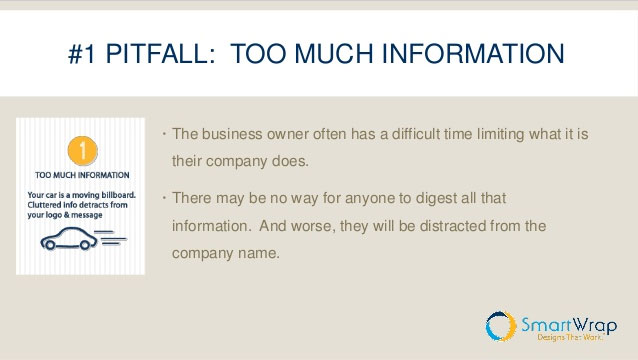Vehicle Wrap Design | What You Need To Know
May 29, 2014
Vehicle Wrap Designs – Inconsistent or Confusing Data
November 21, 2014Too Much Information on Your Vehicle Wrap Could Hurt Business

Advertising is constantly evolving and we now have more and more ways to reach our customers. Vehicle wraps are a great way to get potential customers familiar with your brand but what if you are inadvertently turning them off before they have even seen your message?
This is one common mistake that well-meaning marketers make. While they believe so strongly in their brand that they want to list all the benefits, there is such a thing as too much information when it comes to your vehicle wrap.
Think about it this way – when you see a car with vehicle wrap, you are likely driving or even if you are not, the other car is probably in motion. How much can you possibly read in such a short period of time?
The answer is, not a whole lot. This is why it’s best to keep messaging short and sweet so that it does not distract from the logo or main point. Vehicle wrap should be placed in the same category as a billboard. After all, add some wheels to it and your ad becomes essentially that. Consider how much you can actually see and retain from the billboards you drive past each and every day. Do you remember a billboard with a few simple words and a logo or one that makes you squint or slow down to try and figure what it is all about?
There is such a thing as too much information when it comes to your vehicle wrap.
The answer is clear – we typically follow the less-is-more approach when it comes to reading ads. This is intensified when we are distracted by other tasks, like driving in this case. One benefit that vehicle wraps have over billboards is that we have become so numb to many marketing messages we see on billboard signs that they often go unnoticed. While vehicle wrap has been around for some time now, we are often more apt to tune into these messages and admire the neat colors and interesting designs since we naturally notice moving objects over stationary ones.
Often images appeal to us as well. The old adage “a picture is worth a thousand words” really does ring true when it comes to ads. If we, as consumers, can relate to an ad based on an image alone, we are more likely to remember the brand.
So what happens when you clutter this with TMI?
In a nutshell, money is thrown out the window. If you list each and every service your brand offers then your message is lost, your customers don’t even see your logo or business name and there goes a potentially great campaign.
So how can you make your vehicle wrap a success?
Well, now that you recognize the importance of a short and sweet message also remember to use large, bold writing so that your message is legible. You can also use interesting graphics or colors to catch the eye of potential customers on the road. Adding contact information like a web address or a phone number can also be helpful. You never know when you are reaching a customer at just the right time in the sales funnel that they will want to call and make the purchase right away.
Also, stick to merely one or two messages. Assume that you will only capture the attention of nearby drivers for 5 seconds max. If you want to test the effectiveness of your design, have others (with no knowledge of your company) glance at the wrap for only 5 seconds and see what is retained. People tend to scan, especially when it comes to advertising messages so use this knowledge to your benefit.
The location of your images and text on your vehicle also must be strategized. Randomly placing these things were you find them aesthetically appealing may not be the most productive use of space. Consider that people tend to look at images first and then read left to right. With this knowledge, design a wrap that follows this natural pattern of the eye. If you were to place the image on the right, for instance, the eye may travel directly to the image and completely miss the text.
Tim Hilcove
Google




